Last Updated on August 3, 2024
Technical SEO for beginners might seem daunting if you are getting started, but it’s pragmatic strategy that is essential. Technical SEO, often referred to as the backbone of all SEO efforts, is a pivotal and dynamic discipline.
As businesses and website owners navigate the complexities of improving their online presence, you cannot ignore intricacies of technical SEO. It’s the key to unlocking the full potential of a website’s performance in search engine rankings.
What is technical SEO?
Technical SEO is the practice of optimizing the technical elements of a website to make sure that search engines can efficiently crawl, index, and rank its content. As search engines like Google employ increasingly sophisticated algorithms, staying on top of the latest on-page SEO and off-page SEO strategies alone may not suffice. The foundation, or in this case, the technical underpinning of a website, plays a crucial role in determining how well it performs in the search engine results pages (SERPs).
Let us take a different approach at explaining technical SEO for beginners.
Picture this: You’ve got an awesome website selling handmade soap. It’s got beautiful products, great descriptions, and even some cool blog posts about skincare. But for some reason, it’s just not showing up in Google searches. That’s where Technical SEO comes in!
Technical SEO is like giving your website a tune-up so search engines can find it, understand it, and show it to the right people. It’s all the behind-the-scenes stuff that makes your site run smoothly and look good to search engines.
Let’s say your soap website is called “MySoapBubbles.com”. A few SEO technical changes you will be looking are sire speeds, structure, and responsiveness.
Nobody likes waiting around, especially not Google! You might compress those gorgeous soap photos so they load quicker. Also, you will want Google (and humans) to easily find all your pages. That can be achieved by organizing your soaps by scent, like this:
MySoapBubbles.com/
├── floral-soaps/
│ ├── lavender.html
│ └── rose.html
├── citrus-soaps/
│ ├── lemon.html
│ └── orange.html
└── blog/
├── best-soaps-for-dry-skin.html
└── how-to-store-handmade-soap.html
To ensure better security you have to make sure your site URL starts with “https://” instead of just “http://”. Making your site mobile-friendly is also mandatory as people browse on mostly their phones. You’d make sure your soap site looks good on small screens too.
So that’s the gist of Technical SEO. It’s all about making your site easy for search engines to crawl, understand, and show to potential customers. It’s like tidying up your shop and putting up clear signs so people can find what they’re looking for.
But there’s a whole to be done on technical SEO.
This guide to successful technical SEO offers insights into the fundamental principles and advanced technical SEO techniques that can empower webmasters, digital marketers, and business owners. Here, we’ll explore the crucial aspects that contribute to a well-optimized website and how they intertwine with on-page SEO and off-page SEO.
Technical SEO Checklist: The Fundamentals of Technical SEO
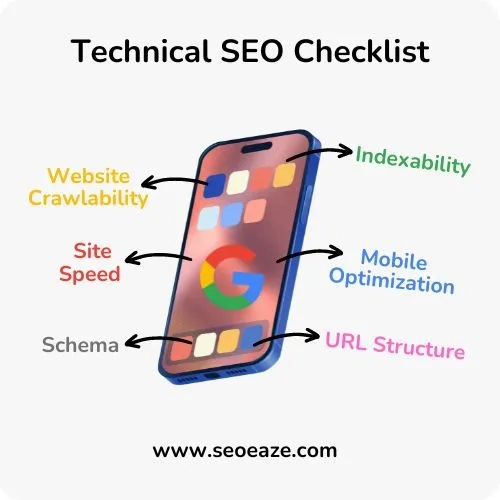 Technical SEO have several factors to look into and understanding the fundamental concepts is the only way to ensure you get it right. Here is the technical SEO checklist
Technical SEO have several factors to look into and understanding the fundamental concepts is the only way to ensure you get it right. Here is the technical SEO checklist
the bedrock upon which a robust online presence is constructed. Before we study the intricacies of specific technical aspects, let’s explore the fundamental concepts that underpin this dynamic discipline.
Website Crawlability and Indexability
At its core, technical SEO makes your website accessible and understandable to search engine crawlers. Search engine spiders continually traverse the web to discover and index web pages.
According to a study by Ahrefs, 90.63% of pages get no organic search traffic from Google. This is because of the crawlability and index issues. A research by Botify shows that on average, search engines crawl only 51% of a website’s pages. This underscores the importance of optimizing your crawl budget.
Ensuring they can effectively crawl and index your site’s content is paramount. By optimizing your website’s crawlability and indexability, you’re laying down a clear path for search engines to navigate and comprehend your website’s structure and content.
Site Speed and Performance
Website speed is a essential ranking factor for search engines and a crucial component of the user experience. Slow-loading pages can drive users away and result in lower search engine rankings. Google found that as page load time increases from 1 second to 3 seconds, the probability of bounce increases by 32%. This highlights the critical importance of speed for user retention.
For technical SEO, page load speed optimization is a key consideration. Techniques such as image optimization, browser caching, and content delivery network (CDN) implementation can significantly enhance your website’s speed and overall performance.
Mobile Optimization
According to Google, mobile-friendly websites show up higher in search results since the introduction of mobile-first indexing in 2019. With the proliferation of mobile devices, ensuring your website is mobile-friendly is essential.
With mobile-first indexing, search engines primarily use the mobile version of your website for ranking and indexing. A responsive design, mobile usability, and swift load times on mobile devices are all integral components of technical SEO.
Structured Data and Schema Markup
Incorporating structured data, also known as schema markup, can enhance your search engine visibility by providing context to search engines about the content on your pages.
According to Google, pages with valid structured data are eligible for Search features like rich results and Knowledge Panel entries, potentially increasing visibility in search results.
URL Structure and Canonicalization
Your website’s URL structure can significantly impact your SEO efforts. Clean and concise URLs that reflect the content’s hierarchy are favored. Additionally, canonicalization is critical in preventing issues related to duplicate content. It also ensures that search engines correctly index and rank your preferred page version.
Google’s documentation emphasizes that canonical tags help prevent duplicate content issues, which can affect a site’s search performance.
These fundamental aspects can be considered the building blocks of technical SEO. Once you get them right, you can move to a broader range of elements to fortify your website’s technical SEO.
Website Structure and Crawling
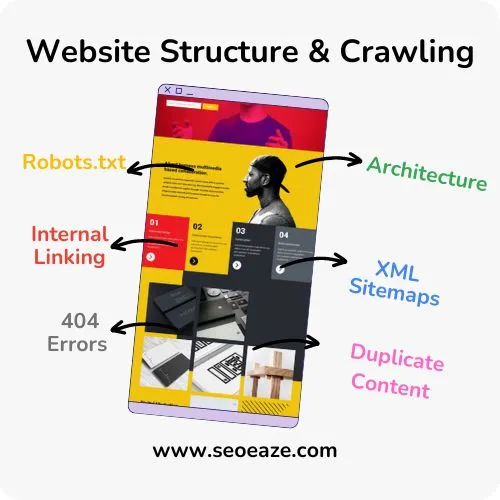 A well-structured website is like a well-organized library; it makes information easy to find, whether for a visitor or a search engine crawler. In the realm of technical SEO, the website’s structure and how it’s crawled and indexed are vital considerations.
A well-structured website is like a well-organized library; it makes information easy to find, whether for a visitor or a search engine crawler. In the realm of technical SEO, the website’s structure and how it’s crawled and indexed are vital considerations.
Depending on the stack used within a website, there can be hundreds of elements that need adjustment to optimize the website; the most crucial ones are:
Website Architecture: The structure of your website is akin to the architecture of a building. A robust, logical, and user-friendly architecture not only aids in navigation but also influences how search engine crawlers perceive your content. Ensuring your website is organized that makes sense to human visitors and search engine robots is a fundamental principle of technical SEO.
XML Sitemaps: An XML sitemap is like a roadmap for search engine crawlers, providing a detailed list of all the pages on your site. By creating and submitting an XML sitemap, you guide search engines to your website’s critical content. A well-maintained sitemap is crucial to any SEO technical checklist, ensuring your pages are discovered and indexed.
Robots.txt: Think of robots.txt as the gatekeeper of your website. It instructs search engine crawlers which pages to crawl and index and which to avoid. Properly configuring your robots.txt file can prevent sensitive or unnecessary pages from being indexed, which is a part of the technical SEO audit process.
Internal Linking: How your website’s pages link is a fundamental aspect of your website’s structure. A well-thought-out internal linking strategy not only helps users navigate your site but also distributes PageRank and authority throughout your site, benefiting SEO.
Duplicate Content Issues: Addressing and mitigating duplicate content is crucial to technical SEO. Search engines frown upon duplicate content, which can lead to confusion about which page to rank. Implementing canonical tags and redirects is part of the technical SEO audit designed to manage and resolve duplicate content.
404 Errors and Broken Links: Ensuring your website is free of broken links and 404 errors is a fundamental aspect of technical SEO. These errors can be frustrating for users and harm SEO. Regular monitoring and maintenance to fix broken links are essential.
A website’s structure and navigation are essential in deciding how easy it is to crawl and index the website. Additionally, it also enhances the user experience and contributes to improved search engine rankings.
Mobile Optimization and Page Speed
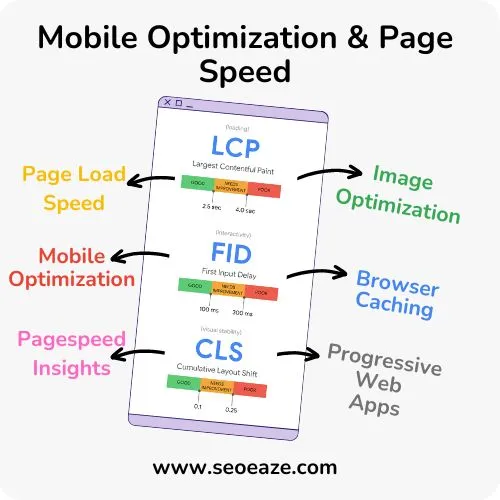
Google switched to mobile-first indexing back in 2020. That’s why a website’s performance on mobile devices and its page load speed are two critical factors that significantly impact user experience and SEO rankings.
Mobile optimization and page speed are integral for successful technical SEO. Make sure your technical SEO audit includes the following:
Mobile Optimization:
As mobile devices have become the primary gateway to the internet, ensuring your website is mobile-friendly is no longer optional—it’s imperative. Google’s mobile-first indexing prioritizes the mobile version of your site for search rankings. A responsive design that adapts to various screen sizes and mobile usability features is paramount. Mobile optimization is an integral part of a technical SEO audit, as it significantly impacts the user experience and SEO performance.
Page Load Speed:
Page load speed is not just a user experience concern; it’s a critical ranking factor for search engines. Slow-loading pages can deter users and lead to lower search engine rankings. Part of any comprehensive technical SEO strategy involves optimizing page load speed. This may include techniques like image optimization, browser caching, and implementing content delivery networks (CDNs) to enhance website performance.
Image Optimization:
Images are essential for engaging content but can also be resource-intensive, leading to slower load times. As part of a technical SEO approach, compressing and optimizing images without sacrificing quality can significantly improve load times and the overall user experience. This optimization process is often included in the SEO technical checklist.
Browser Caching:
Browser caching is a technique that stores certain site resources on a user’s device, reducing the need for repeated downloads. This improves page load speed and overall performance. Including browser caching in your technical SEO audit is an effective way to optimize your site and enhance user experience.
Content Delivery Networks (CDNs):
CDNs are a network of geographically distributed servers that deliver web content to users more efficiently. By utilizing CDNs, you can reduce latency and improve load times, which is crucial for mobile optimization and overall website performance. This technique is a valuable addition to any SEO technical checklist.
Technical SEO for Progressive Web Apps (PWAs):
Progressive Web Apps offer an advanced approach to mobile optimization. These apps deliver a native app-like experience in a web browser, with offline functionality and faster load times. Ensuring your site is compatible with PWAs can give you a competitive edge in mobile optimization.
Till now, our guide has covered the fundamental aspects of website design and performance. Next, you must optimize the on-page SEO elements to provide a seamless user experience for higher search engine rankings.
Technical On-Page SEO
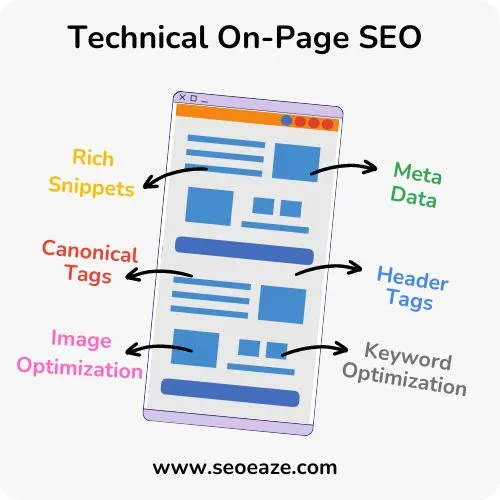
On-page SEO is often the first thing that comes to mind when considering SEO optimization. However, the technical aspects of on-page SEO form the foundation for your content to perform well in search engine results.
Let’s explore the key elements of technical on-page SEO and how they are crucial in any comprehensive technical SEO audit.
Meta Tags and Titles:
Meta tags and titles are the first elements search engines and users encounter when interacting with your content. Ensuring that these are keyword-optimized and accurately reflect the page’s content is essential. A well-optimized title tag and meta description can significantly impact click-through rates from search results.
Header Tags and Content Structure:
Properly structured content is not only easier to read for users but also more understandable for search engines. Using header tags (H1, H2, H3, etc.) to organize your content hierarchy and provide context helps search engines understand the importance of different content sections.
Keyword Optimization:
Incorporating keywords in your content is a fundamental aspect of on-page SEO. However, it’s not just about stuffing keywords haphazardly. It’s about strategically placing and using keywords naturally, user-friendly. Keyword optimization is a crucial checkpoint in any SEO technical checklist.
Image Optimization:
Images can significantly enhance the user experience but should be optimized for SEO. This involves adding descriptive alt text, reducing image file sizes to improve load times, and ensuring images are relevant to the content.
Canonical Tags:
Canonical tags address duplicate content issues, guiding search engines on the preferred version of a page. Including canonical tags is a vital aspect of technical SEO to ensure that search engines correctly index and rank your content.
Structured Data and Schema Markup:
Implementing structured data and schema markup can help your content stand out in search results by providing additional context to search engines. This markup is particularly valuable for certain content types, such as articles, recipes, and events.
Content Optimization:
High-quality, relevant, and engaging content is on-page SEO’s core. Ensuring your content aligns with user intent, answers their questions, and provides value is paramount. Content optimization involves the words on the page and the overall user experience.
URL Optimization:
SEO-friendly URLs that reflect the content hierarchy and keywords can improve click-through rates and user experience. Optimizing your URLs is a common practice in on-page SEO.
Internal Linking:
Using internal links to guide users and search engines to other relevant pages on your site is a part of content optimization. It helps distribute authority and PageRank across your site.
Multimedia Optimization:
If your content includes videos or other multimedia elements, ensure they are optimized for search engines and user experience. Providing transcripts, captions, and descriptive text for multimedia can enhance accessibility and SEO.
Incorporating these elements of technical on-page SEO into your content is essential for maximizing the impact of your on-page efforts.
Schema Markup and Rich Snippets
Schema markup is a specific vocabulary of tags that can be added to the HTML of a web page to provide search engines with structured information about the content on the page. This structured data helps search engines understand the content context, which can result in enhanced search results.
Why include schema markup?
Schema markup makes your web pages more comprehensive to search engines. It provides search engines with more detailed information about your content, allowing them to present rich snippets in search results. Rich snippets can include elements like star ratings, product prices, publication dates, and more, making your listings more informative and engaging to users. This can lead to higher click-through rates and improved visibility in search results.
URL Structure and Canonicalization
An SEO-friendly URL is easy to read, relevant to the content it represents, and contains keywords. Best practices for creating SEO-friendly URLs include using hyphens to separate words, keeping URLs concise, and avoiding special characters or excessive parameters. Well-structured URLs can improve user experience and search engine rankings.
Duplicate content issues can arise when multiple URLs lead to the same or very similar content. Canonical tags help resolve this problem by indicating the preferred version of a page. Search engines will then consolidate ranking signals for all similar pages and attribute them to the canonical URL. This ensures that the preferred page is indexed and ranked correctly.
XML Sitemaps and Robots.txt
XML sitemaps are a valuable tool in SEO. They serve as a roadmap for search engine crawlers, providing a list of all the pages you want search engines to index. Sitemaps help search engines discover and understand the structure of your website, ensuring that your content is crawled and indexed efficiently. To create an effective XML sitemap, it should include all your essential pages, follow specific formatting guidelines, and be kept up to date. Once created, you can submit the sitemap to search engines through their webmaster tools or search console. This process helps search engines recognize and utilize your sitemap for crawling and indexing.
How to utilize the robots.txt file to control search engine crawlers?
The robots.txt file is a directive that tells search engine crawlers which pages or sections of your website can crawl and index. It’s a valuable tool for managing what content is exposed to search engines. Properly configuring your robots.txt file can help you protect sensitive information and ensure that search engines focus on indexing your most relevant and valuable content. It’s essential to controlling your website’s presence in search results.
Ranklogs Site Auditor-The ultimate technical SEO audit tool
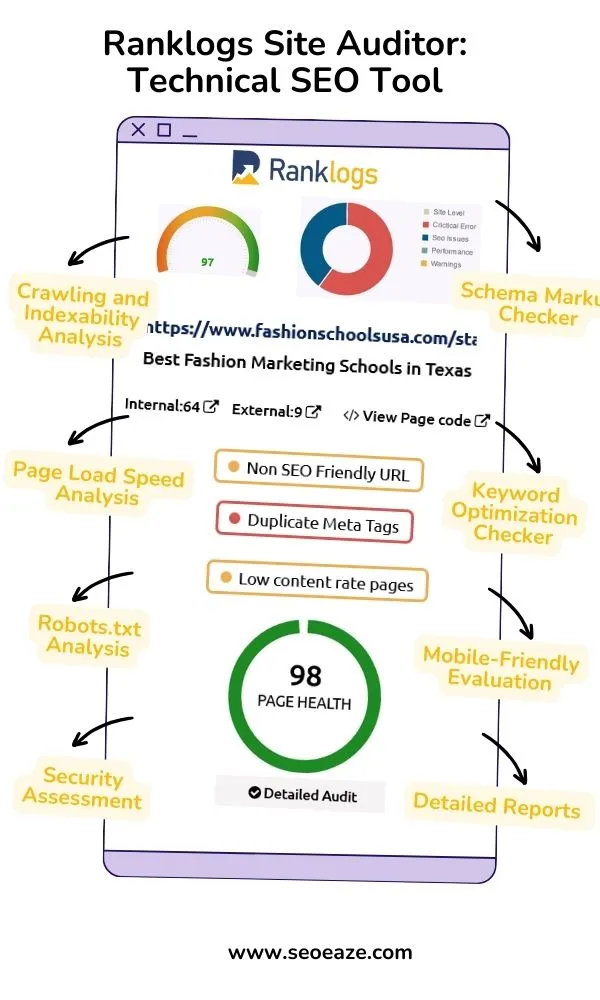 Conducting a comprehensive SEO audit is a fundamental step in understanding your website’s current state, identifying areas for improvement, and optimizing your digital presence for search engines. Several tools are available to facilitate this process, and one tool that stands out for its effectiveness in performing an SEO technical audit is Ranklogs Site Auditor.
Conducting a comprehensive SEO audit is a fundamental step in understanding your website’s current state, identifying areas for improvement, and optimizing your digital presence for search engines. Several tools are available to facilitate this process, and one tool that stands out for its effectiveness in performing an SEO technical audit is Ranklogs Site Auditor.
Ranklogs Site Auditor is a robust and user-friendly tool designed to help website owners, digital marketers, and SEO professionals streamline evaluating a website’s technical SEO health. Here are some of its key features:
Crawling and Indexability Analysis: Ranklogs Site Auditor meticulously scans your website, assessing how effectively search engines can crawl and index your content. It identifies potential roadblocks, such as broken links, duplicate content, and missing meta tags, which could hinder your SEO efforts.
Keyword Optimization Checker: This feature helps you analyze how well your web pages are optimized for your target keywords. It highlights opportunities to enhance on-page SEO by identifying keyword density and prominence providing suggestions to improve your keyword strategy.
Page Load Speed Analysis: Site speed is crucial for user experience and SEO. Ranklogs Site Auditor evaluates the load times of your pages and offers insights into potential performance improvements. It helps you identify and address issues causing sluggish load times.
Mobile-Friendly Evaluation: With mobile optimization being a significant SEO factor, this tool assesses the mobile-friendliness of your website. It provides recommendations for enhancing the mobile user experience, a critical aspect of technical SEO.
Schema Markup Checker: Ranklogs Site Auditor recognizes the importance of structured data and schema markup for SEO. It checks for schema markup on your pages and ensures it is correctly implemented to enhance your chances of securing rich snippets in search results.
XML Sitemap and Robots.txt Analysis: The tool examines your XML sitemap and robots.txt files, verifying their accuracy and effectiveness in guiding search engine crawlers. It ensures that your website provides the necessary guidance to search engines for efficient indexing.
Security and HTTPS Assessment: With web security playing a significant role in SEO, Ranklogs Site Auditor checks your website’s security measures and SSL certificate implementation. It provides recommendations to enhance website security, essential for trust and SEO performance.
Detailed Reports and Recommendations: After a thorough analysis, Ranklogs Site Auditor generates comprehensive reports with clear insights and recommendations for improving your website’s technical SEO. These reports serve as valuable roadmaps for your SEO strategy.
Ranklogs Site Auditor is a powerful tool for conducting a technical SEO audit, allowing you to identify and address issues impacting your website’s performance in search engine results. It offers a holistic assessment of key technical SEO factors and provides actionable recommendations to enhance your website’s visibility and user experience.
Conclusion
Search engine optimization is ever-evolving, but technical SEO efforts for your website’s visibility and user experience remain steadfast and significant. By focusing on the technical aspects listed in this guide, you can ensure that your website is not only search engine-friendly but also equipped to withstand algorithm changes and updates. Remember, technical SEO is an investment in the long-term success of your website. It’s a strategy that elevates your search engine rankings and enhances the overall experience your users have with your site.
